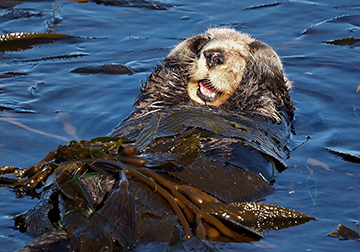
Chapter 2: History of Prior Sea Otter Translocation

Experts such as resource managers use translocations or reintroductions to help a species recover from losses or population reductions caused by human activities (either directly or indirectly). Many documented sea otter translocations, beginning in Russia in 1937, have tried to reverse the harm done by fur trading in the 18th and 19th centuries, as well as other human activities.
A review of these past translocations suggest several key factors that may contribute to successful reintroductions:
- Adequate food resources
- Enough individuals from the appropriate age and sex classes
- Protected areas for resting and pup rearing (e.g., reliable kelp beds or protected bays/inlets)
- Minimal disturbance from human activities (e.g., commercial and recreational boat traffic or tourism activity)
- Low levels of threats such as toxins, fishing gear entanglement, or organisms transmitting disease that could lead to more deaths than typically expected during the establishment phase

Chapter 2
- History of Translocations
- Methods of Translocation
- Lessons Learned
Lessons from Previous Translocations
- Basic otter biology must be accounted for: Early translocations were largely unsuccessful due to the lack of understanding of the basic physiology of sea otters and their dependence on maintaining a thermal balance through their pelage and on an unusually high metabolic requirement.
- Given suitable habitat, prey resources, and protection from human or other causes of death, translocations have proved an important tool in sea otter conservation.
- Even successful reintroductions often undergo an establishment phase during which their ultimate success can be questionable. During this phase, a variety of factors tend to reduce the founding population to a small fraction of its initial number. While some sea otters die, others leave the release site and return to their native home. Sea otter behavior may be more important than food in determining whether otters remain at the release site.
- Translocations can play a role in restoring the ecosystem, including coastal marine ecosystem structure and function, genetic diversity, and genetic connectivity among sea otter populations.

Learn More
- Chapter 1 – Intro
- Chapter 2 – Prior History
- Chapter 3 – Population impacts
- Chapter 4 – Genetic considerations
- Chapter 5 – Ecosystem effects
- Chapter 6 – Habitat suitability
- Chapter 7 – Socioeconomics
- Chapter 8 – Admin/legal issues
- Chapter 9 – Logistics
- Chapter 10 – Health & welfare
- Chapter 11 – Stakeholder issues
- Chapter 12 – Conclusions
- Appendices: ORSO app, maps
Related: Reintroduction Economic Study
Key Quotes
“For any wildlife reintroduction program, individuals must be taken from some source population for translocation to the new habitat. Because removing individuals will necessarily cause a reduction in population size, the question is not whether a source population will be negatively affected but rather if these negative effects will be statistically or biologically significant.”
“Managers and a wide range of stakeholders can easily use the model framework developed for this assessment (the ORSO web app) to explore the potential outcomes of alternative reintroduction scenarios, assess the relative risks and implications …, and evaluate the factors likely to determine a reintroduction’s success or failure.”
Key Terms
Click on the following key terms used on this web page to see their definitions on the glossary page:

